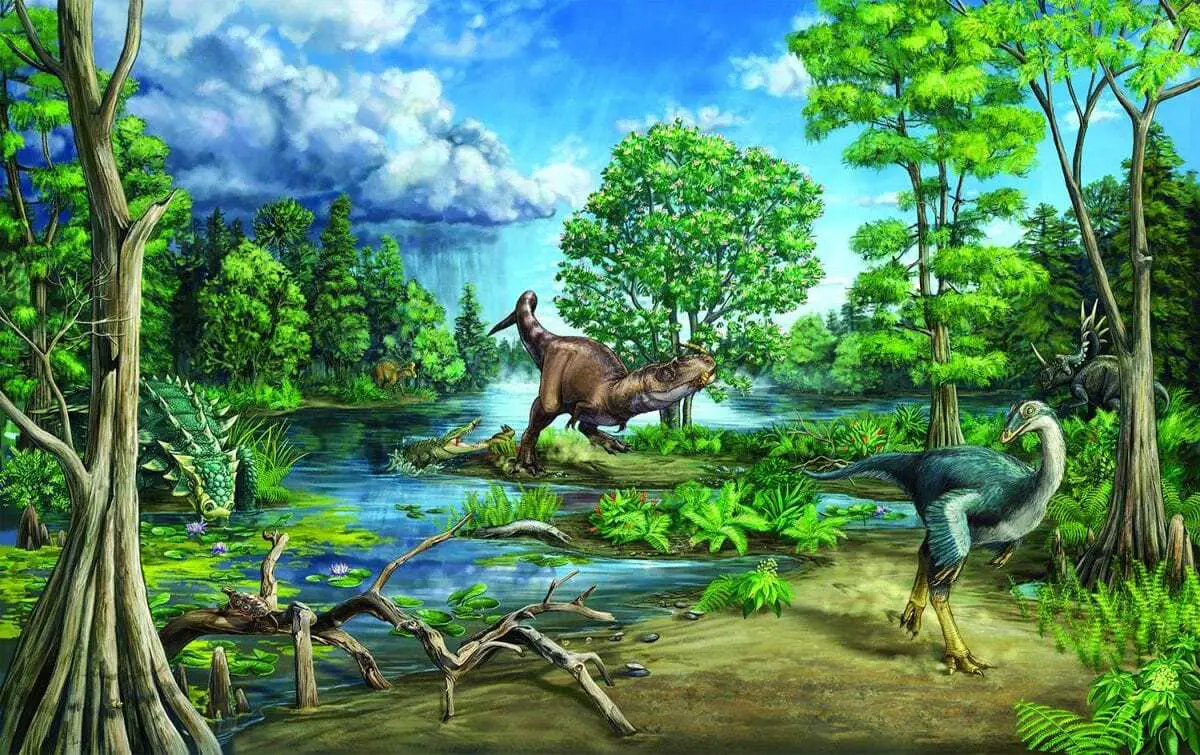A topic of considerable interest to paleontologists is how dinosaur-dominated ecosystems were structured, how dinosaurs and co-occurring animals were distributed across the landscape, how they interacted with one another, and how these systems compared to ecosystems today.
In the Late Cretaceous (~100–66 million years ago), North America was bisected into western and eastern landmasses by a shallow inland sea. The western landmass (Laramidia) contained a relatively thin stretch of land running north-south, which was bordered by that inland sea to the east and the rising Rocky Mountains to the west. Along this ancient landscape of warm and wet coastal plains comes an extremely rich fossil record of dinosaurs and other extinct animals.
Yet, from this record, an unexpected pattern has been identified: Most individual basins preserve an abundant and diverse assemblage of dinosaur species, often with multiple groups of co-occurring large (moose- to elephant-sized) herbivorous species, yet few individual species occur across multiple putatively contemporaneous geological formations (despite them often being less than a few hundred kilometers apart). This is in fairly stark contrast to the pattern seen in modern terrestrial mammal communities, where large-bodied species often have very extensive, often continent-spanning ranges. It has therefore been suggested that dinosaurs (and specifically large herbivorous dinosaurs) were particularly sensitive to environmental differences over relatively small geographic distances (particularly with respect to distance from sea level), and may have even segregated their use of the landscape between more coastal and inland sub-habitats within their local ranges.
In their new study published in Geology, Thomas Cullen and colleagues sought to test some of these hypotheses as part of their broader research reconstructing the paleoecology of Late Cretaceous systems.
One of the methods they’re using to do that is stable isotope analysis. This process measures differences in the compositions of non-decaying (hence, “stable”) isotopes of various common elements, as the degree of difference in these compositions in animal tissues and in the environment have known relationships to various factors such as diet, habitat use, water source, and temperature. So the team applied these methods to fossilized teeth and scales from a range of animals, including dinosaurs, crocodilians, mammals, bony fish, and rays, all preserved together from a relatively small region over a geologically short period of time in sites called vertebrate microfossil bonebeds.
By analyzing the stable carbon and oxygen isotope compositions of these fossils they were able to reconstruct their isotopic distributions in this ecosystem—a proxy for their diets and habitat use. They found evidence of expected predator-prey dietary relationships among the carnivorous and herbivorous dinosaurs and among aquatic reptiles like crocodilians and co-occurring fish species.
Critically, says Cullen, “What we didn’t see was evidence for large herbivorous dinosaurs segregating their habitats, as the hadrosaurs, ceratopsians, and ankylosaurs we sample all had strongly overlapping stable carbon and oxygen ranges. If some of those groups were making near-exclusive use of certain parts of the broader landscape, such as ceratopsians sticking to coastal environments and hadrosaurs ticking to more inland areas, then we should see them grouping distinctly from each other. Since we didn’t see that, that suggests they weren’t segregating their resource use in this manner. It’s possible they were doing so in different ways though, such as by feeding height segregation, or shifting where in the landscape they go seasonally, and our ongoing research is investigating some of these possibilities.”
Another important part of their study was comparing the fossil results to an environmentally similar modern environment in order to examine how similar they are ecologically. For a modern comparison, they examined the animal communities of the Atchafalaya River Basin of Louisiana, the largest contiguous wetland area in the continental U.S. The landscape of this area is very similar to their Cretaceous system, as are many elements of the plant and animal communities (not including the non-avian dinosaurs, of course).
From their comparisons, the team found that the Cretaceous system was similar to the Louisiana one in having a very large amount of resource interchange between the aquatic and terrestrial components of the ecosystem, suggesting that fairly diverse/mixed diets were common, and food being obtained from both terrestrial and aquatic sources was the norm. They also found that habitat use differences among the herbivorous mammals in the Louisiana system was more distinct than among those large herbivorous dinosaurs in the Cretaceous system, lending further evidence to their results about their lack of strict habitat use preferences.
Lastly, the team used modified oxygen stable isotope temperature equations to estimate mean annual temperature ranges for both systems (with the Louisiana one being a test of the accuracy of the method, as they could compare their results to directly measured water and air temperatures). The team found that in their Late Cretaceous ecosystem in Alberta, mean annual temperature was about 16–20 degrees C, a bit cooler than modern day Louisiana, but much warmer than Alberta today, reflecting the hotter greenhouse climate that existed globally about 76 million years ago.
Characterizing how these ecosystems were structured during this time, and how these systems changed across time and space, particularly with respect to how they responded to changes in environmental conditions, may be of great importance for understanding and predicting future ecosystem responses under global climate change. The team’s research continues and should reveal much more about the food webs and ecology of the dinosaurs and other organisms that inhabited these ancient landscapes.
Header Image Credit – Danielle Dufault, Royal Ontario Museum. This mural was originally made for a recent Royal Ontario Museum exhibit about a fossil ankylosaur named Zuul crurivastator. That fossil is found within a couple of meters stratigraphically/temporally of the site described in this paper. The last author on the study, David Evans, is the dinosaur curator at the Royal Ontario Museum and was also involved in the description of Zuul and design of that exhibit.





